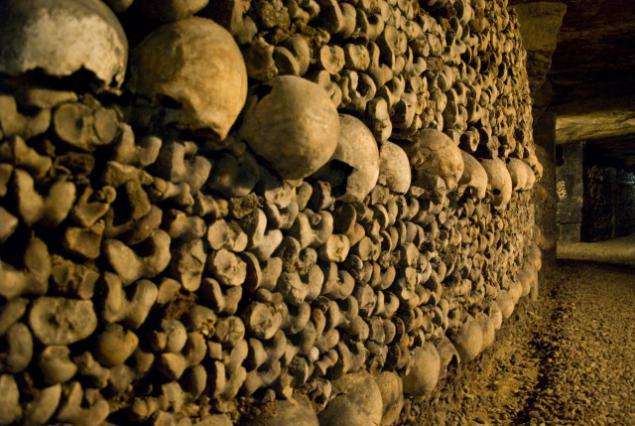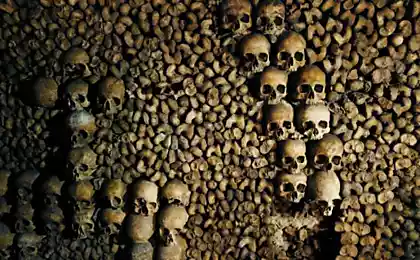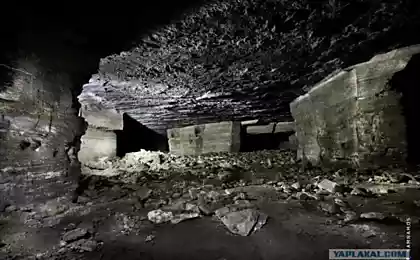727
10 most interesting catacombs of the world, which certainly need to go down
A kind of "time machine" At the word "catacombs" in mind there is an image filled with human bones and crude dark dungeon, which can dare to visit except a man with very strong nerves. But in such a representation is only a small fraction of the truth. In fact, the catacombs are not always gloomy and damp and is not always filled with skulls. Above all, they are a kind of "time machine" that carry them descended people in the hundreds and even thousands of years in the past, and are familiar with the long-vanished traditions and cultures of different eras and different nations. For archaeologists and historians, they have become a real treasure, sheds light on the many mysteries of antiquity.
Paris Catacombs (Paris, France)
Paris Catacombs are a clear illustration of the thesis that before dying anyway. Among the remains of almost 6 million people, who have found in them its last refuge, rest the body of Charles Perrault and Francois Rabelais, Antoine Lavoisier, and Blaise Pascal, Nicolas Fouquet and Jean-Baptiste Colbert and many prominent figures of France. When the end of the XVIII century the catacombs were brought the bones of all the cemeteries within the city walls (including with famous cemetery innocent), it makes no distinction between the deceased. However, the Paris catacombs were used not only for the extraction of stone and the burial of the dead in different eras in the caves and corridors of the underground labyrinth located wineries, a secret bunker, cafes and even a bomb shelter. To establish the exact length of the network of underground caves and tunnels, development of which began in the X century, even in our time is hardly possible. Approximate their area - 11 000 sq. m. For visits allotted only a small portion of a length of 2, 5 km away, but it makes even dared to pass it from beginning to end a lasting impression.
Catacombs of Rome (Rome, Italy)
When it comes to the catacombs of Rome, it is appropriate to ask the question: "Which ones?" - Via Latina or Generoso, Priscilla and Balbino, Valentine's Day or St. Callistus. A total of more than 60, some of them may be as old as himself the Eternal City. But above all, they refer to the times of Late Antiquity, the era of the gradual decline of the Roman Empire, the first Christians, saints and martyrs, some of which have found their final resting place in loculi and arkosoliyah catacombs. This is a real treasure for lovers of art and history: almost everywhere perfectly preserved frescoes and inscriptions, and sometimes entire mosaic. Every catacombs are unique in their own way. For example, in the catacombs of Priscilla is the oldest known image of the Virgin, and in the catacombs of St. Sebastian, according to legend, the relics of the Apostles Peter and Paul. In addition to the early Christian, Jewish and pagan survived catacombs with its own unique design. The total length of the underground galleries and caves - more than 150 km. Saying that the Roman catacombs reveal all their secrets, it is too early: perhaps in the future they will present more surprises archaeologists and historians.
Catacombs of Kom el-Shukaf (Alexandria, Egypt) 43,548,304
If it was not accidental collapse of the ancient arch near Pompey's Pillar of Alexandria in 1900, quite possibly, the catacombs of Kom el Shukaf would discover much later. They were hidden from the eyes of almost one and a half thousand years. But to find in this case - is half the battle. Large-scale restoration and archaeological work, pumping groundwater, strengthening the walls - all this has taken away a huge amount of time and effort, and in fact the lowest tiers are still flooded. The catacombs were opened to the public only in 1995. Starting with the II and IV century BC they were used for burial and commemoration of the dead. Decoration of halls and corridors emphasizes the fusion of tradition and culture that prevailed in Alexandria during the period of late antiquity. The elements of Greek, Roman and Egyptian styles fused into one. The catacombs were buried as the nations and the early Christians. It is noteworthy that in Arabic they are sometimes called Ra-Kedil that roughly translates as "Mound of shards': in ancient times after the funeral rites were not accepted to take away with them the dishes, and her pieces are still covered the floor of the underground necropolis.
Read more on the website «Forbes»
via www.forbes.ru/stil-zhizni-slideshow/puteshestviya/80696-10-katakomb-v-kotorye-nepremenno-nuzhno-spustitsya/slide/1
Paris Catacombs (Paris, France)

Paris Catacombs are a clear illustration of the thesis that before dying anyway. Among the remains of almost 6 million people, who have found in them its last refuge, rest the body of Charles Perrault and Francois Rabelais, Antoine Lavoisier, and Blaise Pascal, Nicolas Fouquet and Jean-Baptiste Colbert and many prominent figures of France. When the end of the XVIII century the catacombs were brought the bones of all the cemeteries within the city walls (including with famous cemetery innocent), it makes no distinction between the deceased. However, the Paris catacombs were used not only for the extraction of stone and the burial of the dead in different eras in the caves and corridors of the underground labyrinth located wineries, a secret bunker, cafes and even a bomb shelter. To establish the exact length of the network of underground caves and tunnels, development of which began in the X century, even in our time is hardly possible. Approximate their area - 11 000 sq. m. For visits allotted only a small portion of a length of 2, 5 km away, but it makes even dared to pass it from beginning to end a lasting impression.
Catacombs of Rome (Rome, Italy)

When it comes to the catacombs of Rome, it is appropriate to ask the question: "Which ones?" - Via Latina or Generoso, Priscilla and Balbino, Valentine's Day or St. Callistus. A total of more than 60, some of them may be as old as himself the Eternal City. But above all, they refer to the times of Late Antiquity, the era of the gradual decline of the Roman Empire, the first Christians, saints and martyrs, some of which have found their final resting place in loculi and arkosoliyah catacombs. This is a real treasure for lovers of art and history: almost everywhere perfectly preserved frescoes and inscriptions, and sometimes entire mosaic. Every catacombs are unique in their own way. For example, in the catacombs of Priscilla is the oldest known image of the Virgin, and in the catacombs of St. Sebastian, according to legend, the relics of the Apostles Peter and Paul. In addition to the early Christian, Jewish and pagan survived catacombs with its own unique design. The total length of the underground galleries and caves - more than 150 km. Saying that the Roman catacombs reveal all their secrets, it is too early: perhaps in the future they will present more surprises archaeologists and historians.
Catacombs of Kom el-Shukaf (Alexandria, Egypt) 43,548,304
If it was not accidental collapse of the ancient arch near Pompey's Pillar of Alexandria in 1900, quite possibly, the catacombs of Kom el Shukaf would discover much later. They were hidden from the eyes of almost one and a half thousand years. But to find in this case - is half the battle. Large-scale restoration and archaeological work, pumping groundwater, strengthening the walls - all this has taken away a huge amount of time and effort, and in fact the lowest tiers are still flooded. The catacombs were opened to the public only in 1995. Starting with the II and IV century BC they were used for burial and commemoration of the dead. Decoration of halls and corridors emphasizes the fusion of tradition and culture that prevailed in Alexandria during the period of late antiquity. The elements of Greek, Roman and Egyptian styles fused into one. The catacombs were buried as the nations and the early Christians. It is noteworthy that in Arabic they are sometimes called Ra-Kedil that roughly translates as "Mound of shards': in ancient times after the funeral rites were not accepted to take away with them the dishes, and her pieces are still covered the floor of the underground necropolis.
Read more on the website «Forbes»
via www.forbes.ru/stil-zhizni-slideshow/puteshestviya/80696-10-katakomb-v-kotorye-nepremenno-nuzhno-spustitsya/slide/1
Twenty Dutchman has developed an ingenious plan to cleanse the ocean
How learn 30 languages: the secret polyglots























